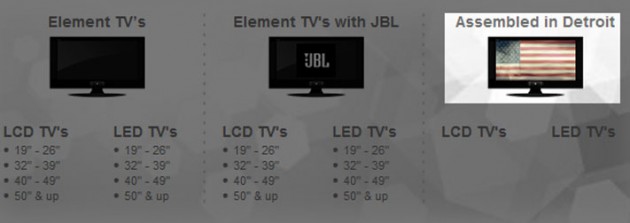Imagine, just for a moment, buying a new 70″ 1080P LED HDTV with a premium JBL sound system, hanging it in your living room, and while installing the cables seeing a sticker on the back that says
“Made in the USA”
A television. Made in the USA.
It sounds like a pipe dream, since major consumer electronics just simply aren’t made here anymore. Other than Olevia’s brief stint in California, no TV has been manufactured in the US for decades. There’s, of course, the idea that labor costs are too high to bother, that unions will somehow ruin everything, and that there’s no point in building electronics anywhere other than Asia, but at least one company we met with at CES 2012 plans to change those perceptions.

HDTVs are large, fragile items. At 46″ and bigger, the cost of insuring and transporting a large, sensitive electronic device across the ocean becomes prohibitive. Thus opens a serious case for manufacturing them a bit closer to home.
That’s what Element Electronics CEO Mike O’Shaughnessy figured, and that’s where the journey to bring television manufacturing back to the United States begins.
Blue Collar Beginnings
Mike was born in the blue-collar town of Warren, Ohio. Warren shares northeastern Ohio with Akron, Cleveland, and Youngstown. It’s as rust belt as you can get. You can therefore begin to see how someone who was born and raised in this kind of area would think of trying to revive high tech manufacturing in America.
Element Electronics is based in Minnesota, and Mike told me candidly that the decision to find manufacturing in America was partially economic and partially patriotic. Of course, any CEO would be foolish to make a move like this if it wasn’t a smart financial decision, but Mike believes that all the pieces are in place for this to make sense.
The electronic components inside the televisions are still being manufactured offshore, but the final assembly will be done in Canton, Michigan (a suburb of Detroit). This is very similar to how the automotive process works.
“Our hope is that by ramping up production on a small scale, we’ll start to see it make sense for suppliers to think about opening up their doors in Michigan to accommodate our production. We have to start small, and this is our first step.”
Mike talks about big plans; the Element plant is starting with a single manufacturing line that will be able to crank out 500,000 units. The factory has room for up to five lines. “Think about it, if we start rolling out five full production lines, suppliers are going to take notice and we can start seeing these other factors come into play. There’s a huge labor and talent pool in the midwest. You’ve got workers with high-tech experience here. Plastic injection molding, assembly, fabrication, you name it. It can be done here, it’s just a matter of economy of scale.”
Since I knew Detroit-area residents would want to know, I asked about using union labor. Mike was again perfectly candid with me. “Not initially, but I want you to know that I’m not against union labor.” and then he told me about his blue collar beginnings, which was a roundabout way of saying that he would support union labor if the economics made sense.
Element televisions are being manufactured in a partnership with Lotus International Company. The Lotus plant is where the TVs will be built.
But are they good?
This is all well and good, but we all know that Element is not exactly a premium brand—and features, quality, and support will win out over fleeting feelings of patriotism. I was brought into a room to demo their product line, where I was surprised to find out that a JBL representative was on hand to reveal that Element has partnered with them to provide premium audio solutions for the sets.
An Element LED HDTV was next to a Samsung unit. The picture quality on both sets was essentially the same; the colors were of course different, but these things are user adjustable. The Element set looked slightly better, but I attributed that to careful setup from their technicians. I’m reasonably sure they didn’t tweak the competitor’s image settings. The sound demo began. The difference between the two was remarkable. The JBL system on the Element TV was far more possessed of depth, bass, and “room-fillingness” than the Samsung set. Mike explained in his up-front manner:
“We have tremendous respect for the big guys,” presumably referring to Samsung, Sony, LG, and other mainstream TV manufacturers. “These guys have refined their product down to shaving millimeters off the thickness. We’re not there, and we can’t compete on that. We felt that we could compete on a feature basis, and partnering with a strong brand like JBL enables us to do that.” He feels that many consumers will be reassured by a recognizable brand name like JBL, and that the superior audio experience might tip the scales given that both displays are very similar on an image quality basis.
And he may be right. Given a handful of televisions side-by-side, with tweaked image settings, your average consumer will be hard pressed to explain exactly why this or that set “looks” better. It’s all going to be personal preference. However, most will agree on what sounds better, especially when it’s a high-end premium audio solution rather than two cheap speakers in the bottom bezel.
Element televisions that will be manufactured in Michigan are 46″ and up. In their suite at CES I saw 70″ sets and a gorgeous 80″ display as well. The Element product line contains both LCD and LED 1080p displays,. Production of the 46″ and up sets will begin in Detroit in March. They will be available at major retailers such as Wal-mart, Sears, and Costco.
If you’ll be shopping for an HDTV in 2012, it meets all your feature requirements, and it would make you feel good to buy a TV made in the USA, go check out an Element display in a few months. You may be able to proudly say that you bought an American-made television.

















 Articles RSS
Articles RSS